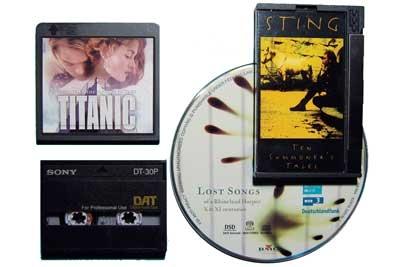Thanks for the Memories

"So long, farewell, auf Wiedersehen, goodbye." So goes the song. But only some of those sentiments apply to four digital-audio formats that have gone, or are about to depart, from the consumer-electronics scene. DAT, DCC, MD, and SACD never did fare "well" in the marketplace. Even more inappropriate is "auf Wiedersehen" - literally, "until we see each other again" - for these media are not likely to return.
Digital Audio Tape, or DAT, was sacrificed from the marketplace to bring us the Audio Home Recording Act (AHRA) of 1992, the legislation that protected, with restrictions, digital audio recording until the still-controversial Digital Millennium Copyright Act (DMCA) of 1998. DAT was supposed to replace two analog formats - the cassette and open-reel tape - but because of the lengthy delay in its introduction (due to the negotiations over the AHRA, in which I participated), DAT never got a chance to gain traction with consumers. The format did make some inroads among professionals, who used it for high-quality two-channel recording until CD recorders and, especially, computer recording and editing became feasible.
Marking the introduction of "lossy" digital-audio compression in consumer media, both the MiniDisc (MD) and the Digital Compact Cassette (DCC) were also intended to replace the analog cassette. MD was moderately successful overseas, and it introduced many listeners to some of the now-familiar advantages of today's portable digital-recording media, including the ability to compile favorite tracks and shuffle randomly among them. DCC was backward-compatible with analog cassettes (which were playable on DCC machines), but that was the system's only advantage; it was discontinued in 1996, just four years after its introduction.
Parts of MD and DCC live on, however. Sony's ATRAC3 MD codec survives as an encoding option in the company's MP3 players (as well as in the RealAudio streaming-audio format). And MP3 itself is a more aggressively "lossy" version of DCC's PASC (Precision Adaptive Sub-band Coding) codec.
Super Audio CD (SACD) is still here for the moment, especially overseas, where many important releases originate. And in this country, it's being kept alive by the valiant efforts of Telarc, primarily. But its days are probably numbered. Of the two competing multichannel music formats - the other being DVD-Audio - SACD faces the more substantial obstacles to survival. Among these are: 1) the lack of an SACD playback function in most DVD players; 2) the lack of SACD compatibility in any announced Blu-ray Disc or HD DVD player; 3) the rapid drop-off in new SACD releases, led by Sony, the system's main proponent; 4) a mathematically proven flaw in the format's 1-bit DSD (Direct Stream Digital) encoding system that requires it to produce noise modulation and distortion, albeit at low levels; and 5) the inability of conventional digital signal processing to efficiently handle the 1-bit encoding, which accounts for the continued lack of good bass management and speaker-distance compensation in most SACD-capable players.























































